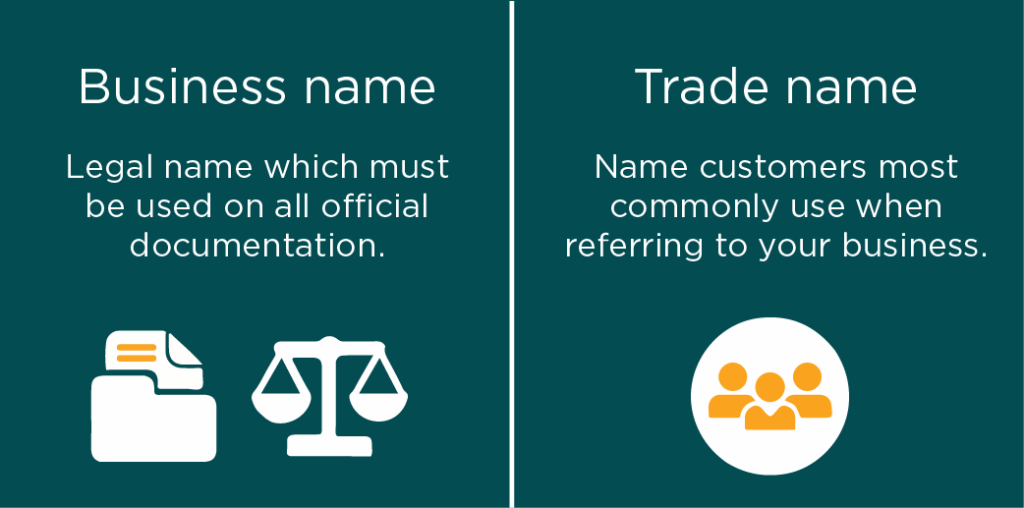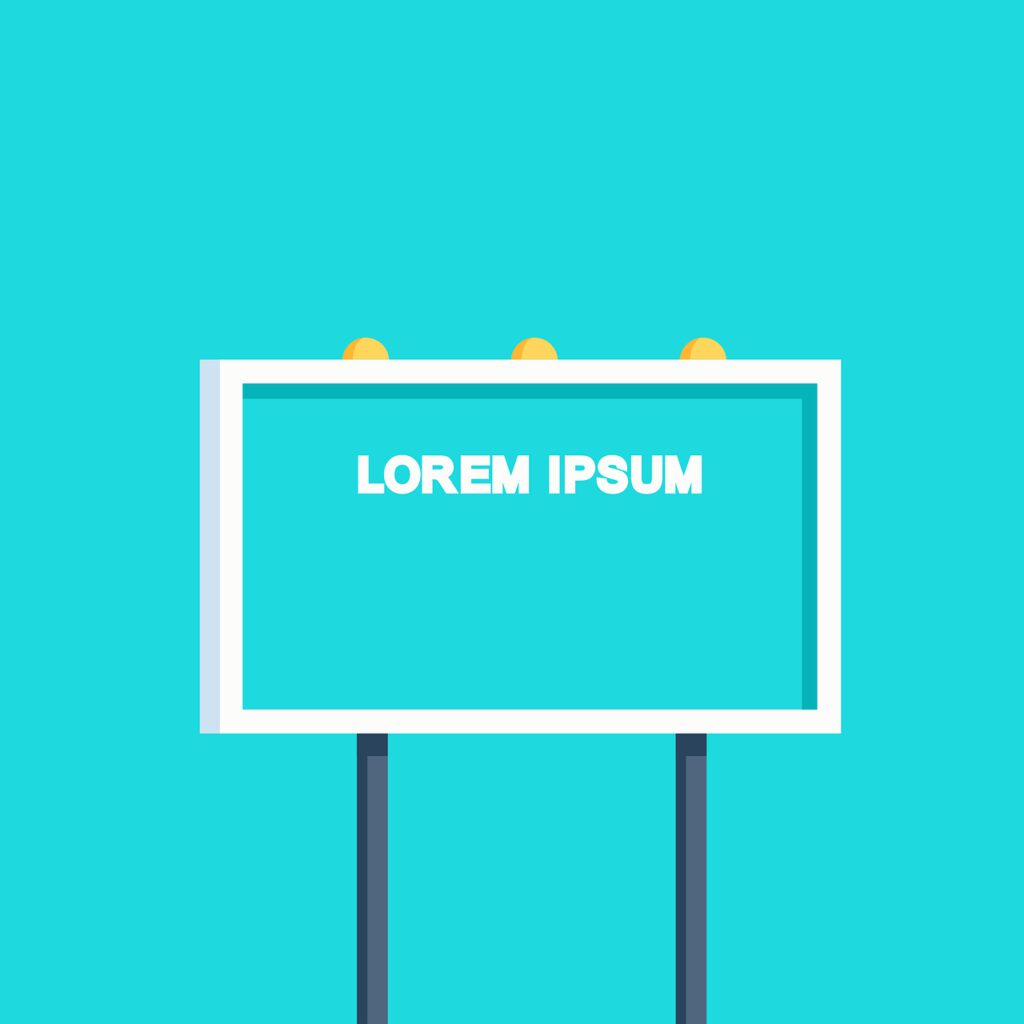Choosing your businesses name will likely take you some time and it will be an iterative process, going back and forth between the different choices you come up with.
That’s ok!
This name will appear in a lot of places, from your webpage, to your products, to press releases. So, make sure you like it, and most importantly it fits your brands identity.
Unfortunately, before you can get all excited about the name choosing process, we have to discuss a few background points when it comes to company names. The first one being, there is a difference between business and trade name and depending on your company type there are a few things to consider.
The difference between a business and a trade name

The busines name is what must be used on all official documentation such as government or business paperwork. The structure and content of that name will highly depend upon your business type. Companies such as freelancers or partnerships must contain the owner’s names, this however is not necessary if choosing business types such as Ltd or LCCs.
With the public name on the other hand, you are free to choose whatever you think fits best to your brands identity and business type. It’s the name that customers most commonly use when they refer to your business and that will be used on any kind of marketing material in print or web.
Going ahead in my blog, when referring to the company name, what I mean is the trade name. I am in no way an expert in this area so please make sure you inform yourself about any legal requirements for your business name. If you would like to learn more on the topic have a look at this page.
What is the difference between a company and brand?
If you didn’t already know it, there is, or least can be, a difference between a brand and a company name. Therefore, I want to take some time to discuss the difference and explore how having a different name for company and brand can be part of your overall marketing strategy.
Company typically refers to the organisation itself, that manufactures and sells the goods or services. The brand on the other hand typically is what the target audience of those products thinks to be the producer of those goods. Therefore, to some degree it’s the personality that a company applies to its products or services. That’s said, company and brand can be one and the same, and what you decide to do highly depends upon your product diversity and marketing strategy.
Take AB InBev, a big company merger between Interbrew, AmBev and Anheuser-Busch. Although they have a yearly revenue of 52.33 billion US Dollars and most people around the world consume their products regularly, most of their customers will have never heard of them. This is because they don’t sell their products under the company but rather a brand name. The reason for this is that they are the world largest brewer or in other words they are accountable for about 30% of global beer sales! Now especially nowadays, consumers of beer love diversity and pride themselves in having a favourite beer for a variety of reasons. Imagine for second, all their beer would be sold under that one company name after the numerous acquisition this company has made? Yes, it would take away a lot of the (thought) diversity in the beer market. And most notably, consumers “choice” would not be between the about 400 brands AB InBev owns and all the other ones but rather just that one brand and all the other ones. It’s quite easy to imagine how their revenue would take a very big hit. To summarize, if you are planning to produce (or acquire) a variety of products but you don’t want you consumers to know who the producer is, it’s worthwhile to consider splitting brand and company identity.
Another reason why one might make a difference between company and brand is that your products address different customer needs or profiles. If you were to keep marketing them under the same umbrella messaging might get confusing and you might not reach your target audience to the full potential. Quite often in those cases it makes sense to create individual brands that serve the specific consumers. This will quite likely lead to an increase of sales just because you are able to focus your product and messaging to serve just one instead of multiple purposes. A good example for this is Blacktrace, a biotech company with leading expertise in microfluidics. Most of their customers will only know the brands under they which they operate, Dolomite Bio, Dolomite Micro and Particle Works. Although the underlying technology is the same for all of them, they sell different products but most notably serve a very distinct target audience.
That said, if your company’s products are quite tailored to one specific group of people, company and brand can be the very same thing.
7 points to consider when choosing a company name
There are a few things to consider while brainstorming for names, which I summarized below. Personally, I would say it’s quite hard to match them all so just make sure your name ticks the boxes that are most important to your business area.
- Make sure no one else already uses that name
- Don’t choose a very long name
- Make it easy to remember, spell and write
- If you want to expand internationally, consider spelling and sound of the name in different languages
- Have a name that stands out from the crowd
- The name should match your brands identity to inspire the emotions you connect with your brand
- Try to include the business area into the name
How did we come up with “Alva Genomics” as company name
Below are a few tips that made the creative process of actually finding the name easier for me:
- Select a few people to brainstorm that are unbiased towards you and have well mixed character trades
- Check for common themes in names of competing businesses
- Brainstorm names on a white board (digital or otherwise)
- Use a search engine to check if that name is already in use
- Check for trademarks on the name
- Write down the name (by hand and with your brands typography)
- Speak it out loud
- Check that people can’t make up odd abbreviations of your name
Let’s look at everything in a bit more detail. Start off by a big brainstorming session with a selected few decision makers in your company or if you don’t have them yet, friends or family. Just make sure to brainstorm with people that you trust to give honest opinions and involve a mix of creative and logical thinking people. In my opinion brainstorming works best on a whiteboard (virtual or on-side) and if everyone is allowed to just chip in names as they flow. I know it’s hard, you are the founder of that company, it’s your baby and you think you know best. But try and do not interfere otherwise you might miss out on some pretty cool stuff.
Now, here everyone will have different opinions but when we chose the name for our company, I started off by given the process a certain structure. Whatever the name, I wanted to make sure it makes quite clear which business area we are in but at the same time wanted to give it a personal touch that made the name unique and stand out. Therefore, at the start we divided the whiteboard into two sides. One for names that matched the greater area we were going to operate in and another that was to contain names that we felt a connection with. The idea to separate the name into two parts came to me through our competitor research. Here we noticed that most businesses in this area tended to have a two-part name, one of which being a made-up word and the other the general business area.

Back then we used a large white paper for brainstorming, which I actually liked a lot. Nowadays, a lot of companies have moved to remote-only workspace and a range of digital whiteboards solution can be found online. In the image above I used Miro which has a lot of templates for meetings and workshops to agile workflows and many more.
After brainstorming, we started a pre-selection process on both sides to narrow down the possible combinations to a selected few. In fact, for us, there was only really one name left on the “personal” side that ticked all the boxes and that was Alva. It’s a Scandie name which was a common theme on our board and it’s our daughters middle name, so it was quite easy to agree on.
All that was left to choose was the name from the “business” side that we wanted to add on. Here we simply looked at the services that we wanted to provide and the areas in which we intended to expand into. Given we are a bioinformatics consultancy with ambitions to license our own software, words such as assist, and intelligence simply seemed to narrow minded and didn’t quite indicate that we were not just in the IT business but also biology. So, all that was left really was genomics and bio, of which bio really seemed too general.
- Alva Bio
- Alva Logic
- Alva Genomics
- Alva Intelligence
- Alva Data
- Alva Assist
Before we settled on the name, we made sure that it wasn’t used elsewhere or was trademarked. You don’t want to start off your companies’ story with a law suit or fights over Google rankings. Depending on the country you intend to do business in there will be different registers that you can check for already existing company names. Below is a list of governmental websites for official registered company names.
UK
Germany
European business register
This is a very rough overview, if you would like to learn more have a look at this page.
Lastly, especially if you have used a digital whiteboard, try and write down the name and say it out loud…sound ok? Well done!
On another note, something I only noticed much later was that people tend to use the shortest possible version of the name when referring to you company. Therefore, it makes sense to do a sanity check that there isn’t any abbreviation that sound odd or could confuse you with a competitor.
That’s me done, as always good luck and I hope this was useful to you!
